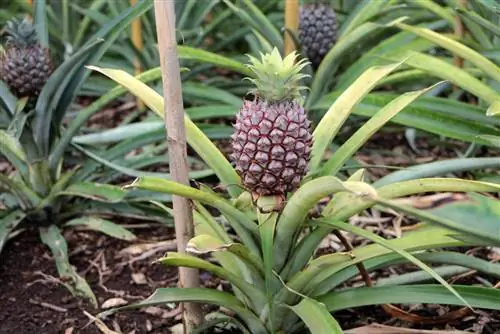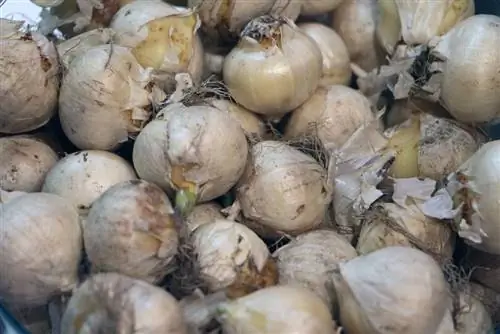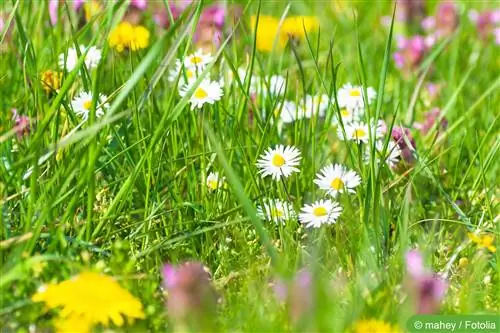- Author admin [email protected].
- Public 2023-12-17 03:39.
- Last modified 2025-06-01 06:48.
Exotic, decorative and easy to care for - the pineapple flower, also known as the crested lily or pineapple lily, is also enjoying growing popularity in our latitudes. Its external appearance resembles a pineapple, with crest-like leaves and flowers that, when combined, look like the fruiting body of a pineapple. The pineapple lily is mainly found in Africa, where it grows at higher altitudes and prefers moist areas. Some of the numerous species and genera of the plant, which is part of the asparagus family, are considered endangered and are on the Red List; All the better when you can look forward to having a specimen in your own garden!
Location and soil
The most important thing for successful cultivation of the pineapple flower is the right location; The plant thrives in areas within the local green area that offer semi-shady to sunny properties. The availability of light also plays an important role in the care of the plant; Although there should be sufficient brightness, there should be no direct or blazing sunlight. Therefore, the pineapple flower should be exposed to the midday heat for a maximum of a short time. The open area within the local green area is not the only possible location; The plant can also be cultivated excellently in a pot. Due to its bizarre appearance, it has a particularly decorative effect as a solitary plant in this container. Since the pineapple lily only grows to around 60cm high, a medium-sized flower pot is sufficient for cultivation. Alternatively, you can choose a bright place in the apartment as a location. In summer the temperature should be around 20°C. In order for the crested lily to feel comfortable, you should not only pay attention to an ideal location, but also to a good substrate. The soil used ideally has the following properties:
- rich in humus
- high permeability
- sufficient nutrients
- One third share of sand
Watering, fertilizing and repotting
In the wild, the pineapple flower grows at higher altitudes that provide sufficient moisture. Anyone who cultivates the plant in our latitudes should therefore also ensure a balanced supply of water. From late spring (May), the crested lily needs to be constantly supplied with water; However, the individual doses must be portioned carefully to avoid waterlogging.
Tip:
Standing water causes the roots to rot. Emptying the saucer helps with potted plants.
So that the pineapple lily can develop its full blooms, it has also proven useful to regularly supply the plant with additional nutrients. Between late May and August, you should therefore apply suitable fertilizer twice a month. Once the crested lily has reached the age of around four years, the plant should be repotted. To do this, place the plant in a slightly larger container that has previously been filled with fresh soil. It is a good idea to get some tubers from this process; these will later be used for propagation.
Wintering
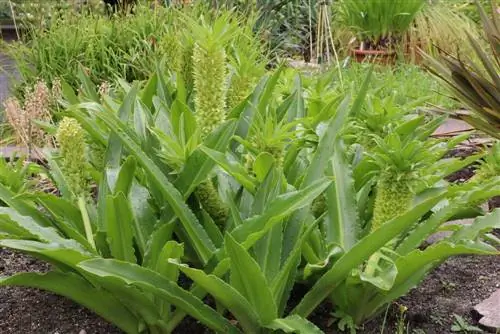
The pineapple flower is not frost-resistant and therefore requires special treatment during the cold season. The plant originally comes from very warm countries and is not used to low temperatures. If the crested lily is cultivated outdoors, it must be moved to suitable winter quarters. The right time for this measure is when the plant has faded; this is usually the case in the first two weeks of October. But at the latest when night frosts threaten, you should definitely bring the pineapple lily into the house. The ideal winter quarters meet the following requirements:
- Temperatures between 6 and 9°C
- dark place
- alternatively, a bright area is also possible
- cool
The classic outdoor plant that has spent the summer in the garden should be given a frost-free place during the cold season and placed in a container with sand. But even if the pineapple lily is kept as a houseplant, it needs an appropriate rest period; That's why the plant should never be left in a warm living room during the cold season. Here too, a timely change of location may need to be considered. The crested lily is not watered during overwintering; The additional supply of nutrients is also stopped during this time. The winter period is over for the pineapple flower as soon as the first rays of sunshine appear in spring; The plant can then be allowed back outdoors as long as there is no longer any risk of night frosts. Within a short time the crested lily will develop its full blooms again.
Planting and Propagating
If you want to cultivate a crested lily, you should choose the end of autumn as the planting time. If you want to plant in a container, use a container half a meter wide; Humus-containing substrate is placed in the pot and three plants are placed in it. The plants are only placed half in the substrate; the upper part looks out. Overwintering then takes place at a moderately cool room temperature. Towards the end of spring you can take the pots outside, either on the balcony orthe terrace or outdoors. However, there should be no risk of frost at this point! The following care rules then apply:
- at first only sparse watering
- only when the first leaves sprout, more moisture is needed
- A lot of water is given out in summer
- fertilization takes place weekly as soon as the pineapple flower presents its green foliage
The propagation of the pineapple flower can be done either with the help of tubers obtained during repotting, or by targeted sowing. Reproduction of the plant works particularly well and, above all, quickly with the help of tubers.
Diseases and pests
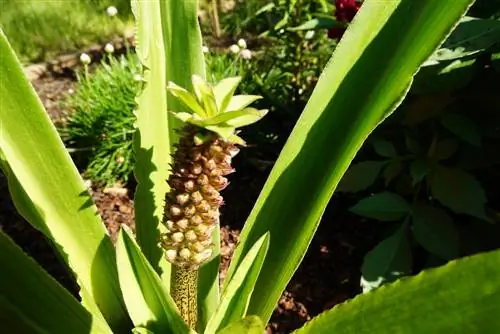
The pineapple flower can be severely affected and become ill due to various care errors. It is therefore important to pay particular attention to even watering. If you don't water enough, the leaves will quickly turn brown and dry out. However, if there is an excess of liquid, there is a risk of waterlogging, which can lead to root damage. It is important to ensure that the liquid can always drain away easily. Typical pests that can affect crested lilies include aphids; To combat the lice, you can spray the lice with a hose or use soap solution. Nettle extracts can also help.
Conclusion
The pineapple plant is relatively easy to care for if the environmental conditions are right and the wintering is optimal. Then every hobby gardener - whether beginner or advanced - can look forward to a Caribbean-looking plant that is guaranteed to enrich any garden!


